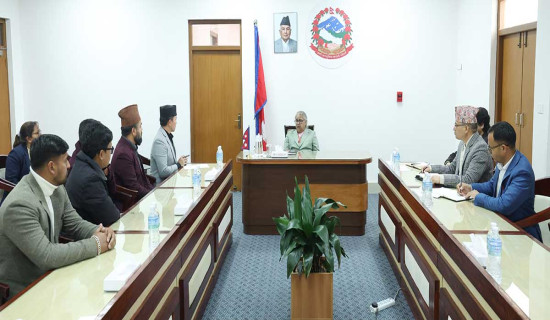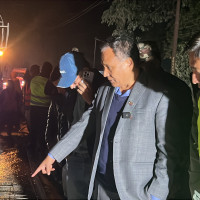- Sunday, 21 December 2025
Gwarko flyover: A milestone in road infrastructure in Kathmandu Valley
Kathmandu, Dec. 11: Flyovers play an important role in reducing traffic congestion along the roads in big cities across the globe. However, Kathmandu has been without one even 150 years after the construction of the first flyover in the UK.
The world’s first railroad flyover was constructed in 1843 at Norwood Junction railway station in London to carry railway vehicles over the Brighton Main Line. Holborn Viaduct, believed to be the world’s first motorable flyover, was constructed at Holborn, the UK, in 1869. Since then, the practice of building flyovers flourished across Europe first and then around the world.
India constructed its first flyover “Kemps Corner Flyover” in Mumbai in 1965. Now several flyovers are built across India.
After more than 150 years of the first flyover was built in the world, and 57 years after its construction in India, Nepal has finally started constructing a flyover at Gwarko, Lalitpur, on Friday.
However, authorities said Gwarko’s might not be the first flyover to come into operation in Nepal
“Construction of the 800 metres long two-lane flyover has already begun at Balambu, Kathmandu. This flyover will be connected with the Nagdhunga Tunnel. The foundation for the flyover has already been constructed,” said Arjun Jung Thapa, director general at the Department of Roads (DoR).
Talking to The Rising Nepal, Thapa informed that Nepal is among a few countries in the world to have no single flyover till date. However, with the commencement of construction of the two flyovers at Gwarko and Balambu, Nepal is going to have at least two fly overs in the next two years. Their successful construction and operation can be a milestone in improving road infrastructures in Nepal.
“The Gwarko Flyover will be the first flyover along the Ring Road and we are certain that it will ease traffic congestion along the section,” said Thapa.
Construction of the four-lane flyover with a 280-metre ramp in one side and a 175-metre ramp in another and a 35-metre-long bridge has been expected to complete in two years.
“The flyover is being constructed under Engineering Procurement Construction (EPC) model. Under this model, we provide a set standard for the flyover and the contractor prepares the design. We have already accepted the design following which the construction work has started,” said Thapa.
The contract to construct the flyover has been awarded to Ashish Samanantar Religare JV under an agreement of Rs. 170 million. The invitation bid for the project was Rs. 330 million. Talking to The Rising Nepal, senior officials of the contractor company informed that they expect to complete the construction in time.
“We have already completed preliminary works. Some major equipment are being imported from France. We are also on standby with construction materials. We are looking forward to completing the construction within the deadline,” said Er. Bishal Karki, an engineer with the contractor company.
Er. Karki informed that after completing the construction, the company would be responsible for its maintenance for the next five years.
Traffic management a major hurdle
The congestion of vehicles along the Koteshwor-Balkhu section of the Ring Road has necessitated a flyover. The Kathmandu Valley Traffic Police
Office (KVTPO) has cleared a 600-metre section on both sides of the fast lane of the eight-lane road from Gwarko Chowk for construction purpose.
The vehicles are diverted to the service lanes for safety during construction.
“We have completed our preparations by conducting geological tests for the construction. However, we believe
that the traffic management would be the major obstacle during the construction. It is because this section of the Ring Road is extremely congested, and we need to be cautious to not affect the service lane at any cost,” said Er. Karki.
Traffic Police officers deployed along the Gwarko section informed that it was a herculean task to manage traffic in the section after restricting the vehicles from plying on the fast lane for 1.2 kilometres. The diversions have been implemented since Friday.
“There are 11 accident blackspots along the Koteshwor-Balkhu section. The major causes behind accidents are overspeeding motorcycles and the jaywalkers crossing the road. Also, buses do not use service lanes and drop/pick passengers from the fast lane,” said Deputy Inspector General of Police (DIGP) Mira Chaudhary, chief of KVTPO.
“More similar projects are in the pipeline, so people should get used to the diversions and restrictions until the flyover is constructed. Traffic management will be difficult unless people abide by the rules and requests,” said DIGP Chaudhary.
“Also, the pedestrians will not be allowed on the flyover,” said Thapa.
More plans along Kathmandu roads
According to the Department of Roads (DoR), there are plans to build more flyovers to ease vehicular movement along the roads of Kathmandu.
DoR’s Director General Thapa informed that there were plans to construct similar flyovers at Satdobato and Ekantakuna area of the Koteshwor-Balkhu section of the Ring Road.
“A Japanese team is also studying the possibility of constructing an underground tunnel below the Tribhuvan International Airport from Tinkune to Jadibuti. We will get concrete details about the project by March, 2023,” said Thapa.
Meagre investment in infrastructure
In January 2019, the Chinese government handed over the 10.5-km Kalanki-Koteshwor road expansion project to Nepal. Started in June 2013 by China’s Shanghai Construction, the China-funded project was completed under an investment of Rs. 5.13 billion.
Spending on road infrastructures after conducting proper study for long-term solutions benefit country in a big way, experts argued.
“The budget allocated for social security and the DoR is almost similar. Moreover, DoR gets only eight per cent of its budget from Nepal while the remaining comes through foreign aid,” said Thapa. In 2021/22, the DoR received a budget of Rs. 129.80 billion while around Rs. 100 billion was spent on social security allowances.
“If the government spent more money on critically important infrastructures, it would provide the much-needed boost for the economy in the long run,” Thapa added.
According to the DoR, several road infrastructures are under construction outside the Kathmandu Valley.
The Mid-Hill Highway construction is going in full pace and the East-West Highway is being expanded to four lanes in different places.
“A tunnel, planned to be constructed in Nawalparasi, will reduce travel distance from Bhairahawa to Kathmandu significantly,” said Thapa.
Meanwhile, Thapa suggested that the authorities should be more serious to build and improve road infrastructures.
















